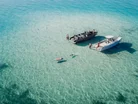Electrified boats won't leave you stranded

Picture a world tarnished by the effects of its own population. The natural environment is disrupted by ill-use and an increasing atmospheric temperature that slowly eliminates all the components of our surroundings that we love to admire. Suddenly, an ocean voyage on a private yacht or a boat trip along the Fjords of Scandinavia sounds imminent, but it need not be this way.
While road transport holds the lion’s share of emissions globally, the marine sector is hot on the tail of cars when it comes to electrification. Much-like their four-wheeled counterparts, boats have undergone the same journey through hybrid-electric propulsion to fully electric, thanks to some of the great minds; innovators behind marine EV technologies.
While the likes of Tesla and traditional OEMs are taking over the road transport sector, aside from Polestar’s batteries there is very little influence from them on the marine sector. Not only does this mean that legacy yacht builders have free reign to inject electrified solutions into the market, but electric boat makers have the space to innovative and creative new products that cater for more than coastal and near-shore activities.
EVs and boating combined to maximise watercraft potential
Enter Candela, the organisation designing boats for a variety of applications in the European waters and beyond—and one of the men tasked with piloting new water craft in the development phase, Mikael Mahlberg, Head of PR & Communications at Candela.
Sharing insight into the EV landscape in Norway, Mahlberg says: “Electric cars are sort of taking over on the roads, but for boats, the sales are super low—maybe less than 0.1% are all-electric boats.”
“Up until now, there hasn’t really been a viable option because conventional boat hulls use so much energy, so just dropping conventional lithium ion batteries into those boats results in disappointing ranges at high speeds.”
But, there are two angles to look at electric boats. The first being the untapped capacity for transport between islands and along coastlines, the other being the sustainable benefits of leveraging waterborne capabilities. Effectively, larger bodies of water form a testing ground for widespread use of hydrofoil technologies.
Such a conversation about hydrofoil technologies and the use of electric propulsion by Candela would not have started if it wasn’t for the company’s founder and his summer trips to the Stockholm archipelago. Gustav Hasselskog believed that, in an era of sustainable transport transformation, he would not have to give up trips with his children to visit neighbouring islands and therefore birthed the idea of all-electric boats that champion longer range capabilities.
“A fairly short trip on his powerboat, around 15 to 20 minutes, would cost him 50 euros worth of gasoline—the ice cream was like five euros. So he then thought about how to build an electric boat that would have long range at high speeds.
Of course, electric being a much cheaper form of transport at the time, the issue with boats is the high levels of resistance from the water beneath them. “He realised that, in order to do that, he needed to drastically reduce the energy usage of boats. The only way to do that is to avoid the friction of water by lifting the hull above the water,” Mahlberg explains.
Hydrofoiling uncovers new electrified capabilities
The use of hydrofoil works wonders for leisure boating with the added benefit to the environment with minimal disturbance of water and life under the surface. That said, hydrofoiling has also made an appearance elsewhere in the marine industry, in particular the E1 Series boat racing championship, which is set to launch in 2023 and provide the same non-disruptive capabilities to powerboats.
The key for organisations like the FIM and Candela is raising awareness of these capabilities as, explained by Mahlberg, those early adopters of electric boats are the same customers sharing open-minded behaviour towards electric cars.
“The first customers were Tesla owners and now the Polestar owners are starting to trickle in as well. Usually these are entrepreneurs and high-wealth individuals that can afford boats, but also early adopters of other technologies,” says Mahlberg.
Talking of sustainability-conscious consumers Candela customers seem to be more inclined to use their boats for leisure purposes, but are often driven by past experiences with day-boating and are looking to minimise their impact while enjoying excursions on the water. As more consumers come around to the idea of electric boating, the industry is starting to see a lot of younger people using them, and Candela alone sees a wider expansion of buyers in other parts of the world.
“We built the C-7 back in 2019 and made 23 of the boats, which were flown all over the world—from New Zealand to the US. You can run them for 92 kilometres per charge when travelling at 22 knots, which is plenty of range for a day boat,” Mahlberg says.
What we can learn from Candela’s work so far is that day-boating is not dead, but it also doesn’t have to impact the environment. Harmoniously integrating leisure boating in various different climates and habitats across the globe proves beneficial from an emissions perspective, but will also have future implications for countries by encouraging sustainable tourism.
Built on the C-8 platform, the P-8 Voyager is built as a passenger boat and is powered by Polestar technologies to enable people to travel to and from high-end resorts and areas like the Northern archipelagos in a decarbonised way.
“Fast charging will be important in order to run a whole day. We’re currently building a ferry called the P-12 shuttle and that boat will leverage fast DC charging up to 180 kW and cover similar distances to conventional diesel ferries.
Read the full article in the May issue of EV Magazine.

